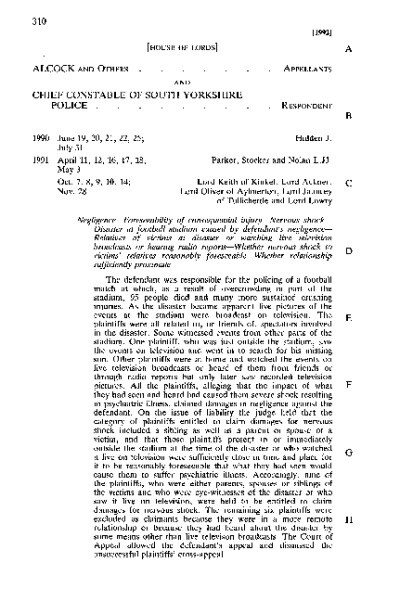
Date
Geographical Area
Europe
Countries
United Kingdom
Case Name
Alcock & Ors v Chief Constable South Yorkshire Police
Case Reference
[1992] 1 AC 310
Name of Court
House of Lords
Key Facts
This was a test case arising from the Hillsborough disaster addressing the issue of liability for psychiatric damage due to a breach of a duty of care by the respondent.
95 people died and many more sustained crushing injuries as a result of overcrowding in part of the Hillsborough stadium in Sheffield, England, which the respondents (South Yorkshire Police) were responsible for policing during a soccer match. There were many people in the stands who observed the disaster first hand and many who observed it on live and/or recorded television and/or through live radio broadcast.
The appellants in this case were friends or relatives of the victims or other spectators in the stadium during the disaster. Some of the appellants witnessed (saw or heard) the disaster by being physically present at the stadium (inside or outside). Some appellants witnessed the disaster through live television or radio broadcast, while others saw it via recorded footage after the fact. Some of the appellants also witnessed the aftermath of the disaster at the temporary mortuary set up in the stadium grounds.
Each appellant alleged that the impact of what they had seen and heard had caused them severe shock resulting in psychiatric illness and claimed damages in negligence against the defendant.
95 people died and many more sustained crushing injuries as a result of overcrowding in part of the Hillsborough stadium in Sheffield, England, which the respondents (South Yorkshire Police) were responsible for policing during a soccer match. There were many people in the stands who observed the disaster first hand and many who observed it on live and/or recorded television and/or through live radio broadcast.
The appellants in this case were friends or relatives of the victims or other spectators in the stadium during the disaster. Some of the appellants witnessed (saw or heard) the disaster by being physically present at the stadium (inside or outside). Some appellants witnessed the disaster through live television or radio broadcast, while others saw it via recorded footage after the fact. Some of the appellants also witnessed the aftermath of the disaster at the temporary mortuary set up in the stadium grounds.
Each appellant alleged that the impact of what they had seen and heard had caused them severe shock resulting in psychiatric illness and claimed damages in negligence against the defendant.
Decision and Reasoning
The legal issue to be determined by the House of Lords was whether, for the purposes of establishing liability in negligence, those who suffer purely psychiatric harm from witnessing an event at which they are not physically present are sufficiently proximate for a duty to be owed, and thus can be said to be reasonably within the contemplation of the respondent.
The House of Lords distinguished between two classes of victims of purely psychiatric damage caused by negligence: primary and secondary.
A primary victim is one who is owed a duty-of-care by the respondent, because he/she suffered a psychiatric harm that was reasonably foreseeable by the respondent and:
• is within the zone of danger created by the negligence;
• is not within the zone of danger created by the negligence but reasonably believes him/herself to be;
• reasonably believes he/she has caused the death or serious injury of another.
In order for a secondary victim to succeed in a claim for psychiatric harm he/she must establish the following in order for a duty to be owed by the respondent:
• A close tie of love and affection to a primary victim;
• Appellant must have been present at the event or its immediate aftermath (proximity);
• Psychiatric injury must be caused by a sufficiently shocking event;
• The psychiatric injury must have been caused by direct perception of the accident or its immediate aftermath and not by hearing about it from someone else (appreciation of the event with their own unaided senses);
• The psychiatric injury must have been foreseeable by the respondent as a likely consequence of exposure to the trauma of the event or its immediate aftermath.
The House of Lords distinguished between two classes of victims of purely psychiatric damage caused by negligence: primary and secondary.
A primary victim is one who is owed a duty-of-care by the respondent, because he/she suffered a psychiatric harm that was reasonably foreseeable by the respondent and:
• is within the zone of danger created by the negligence;
• is not within the zone of danger created by the negligence but reasonably believes him/herself to be;
• reasonably believes he/she has caused the death or serious injury of another.
In order for a secondary victim to succeed in a claim for psychiatric harm he/she must establish the following in order for a duty to be owed by the respondent:
• A close tie of love and affection to a primary victim;
• Appellant must have been present at the event or its immediate aftermath (proximity);
• Psychiatric injury must be caused by a sufficiently shocking event;
• The psychiatric injury must have been caused by direct perception of the accident or its immediate aftermath and not by hearing about it from someone else (appreciation of the event with their own unaided senses);
• The psychiatric injury must have been foreseeable by the respondent as a likely consequence of exposure to the trauma of the event or its immediate aftermath.
Outcome
The House of Lords dismissed the appeal due to the lack of proximity of the appellants as secondary victims.
Disclaimer
This case law summary was developed as part of the Disaster Law Database (DISLAW) project and is not an official record of the case.
Document
Document